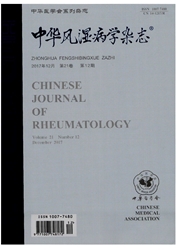

 中文摘要:
中文摘要:
目的探讨分析IgG亚类在原发性干燥综合征(pSS)患者中的临床意义。方法pss血清库中随机检测101例pSS患者、40名健康对照血清,应用免疫散射比浊法检测IgG亚类,分析比较DSS患者和健康对照者IgG亚类分布的差异,并结合临床资料,分析不同临床特征pss患者与IgG亚类的相关性。计量资料正态分布者组间比较用t检验。结果40名健康对照IgG1-4平均值分别为(8085±1566)mg/L,(5406±2151)mg/L,(395±233)mg/L,(566±420)mg/L,所占IgG百分比为(56.8±8.2)%,(36.6±7.8)%,(2.7±1.5)%,(3.9±2.8)%;101例pSS患者IgG1~4均值分别为(14094±5534)mg/L,(3915±1750)mg/L,(565±565)ms/L,(404±504)meCL,所占IgG百分比为(73.0±10.9)%,(21.7±9.8)%,(3.1±2.0)%,(2.2±2.4)%。同健康对照者比较,pSS患者血清中IgG1、IgG3和IgG1/IgG增高,IgG2、IgG2/IgG和IgG4/IgG下降,差异均有统计学意义(P〈0.05);IgG4、IgG3hgG下降,但差异无统计学意义(P〉0.05)。pSS患者中系统受累组与非系统受累组比较,IgG亚类分布特征差异无计学意义(P〉0.05)。IgG正常的pSS患者与健康对照相比,也存在IgG亚类分布异常。结论pSS患者存在特征性IgG亚类分布异常,而抗SSA抗体产生主要与IgG1增高有关,未发现pSS系统受累与IgG亚类分布异常的相关性。
 英文摘要:
英文摘要:
Objective To investigate the clinical significance of IgG subclasses in patients with primary Sjogren's syndrome (pSS) patients. Methods The serum was collected from 101 pSS patients and 40 healthy subjects. The content of IgG subclasses was determined by immuno-scatter turbidmetry. The difference of IgG subclasses distribution between pSS patients and healthy subjects was analyzed. Com-bined with the clinical information of the SS patients, the difference of IgG subclasses distribution in SS patients with different characteristics was analyzed. For group comparisons, measurement data were compared using unpa- ired Student's t test. Results The average levels of serum IgG1-4 in 40 healthy controls were (8085±1566) mg/L, (5406±2151) mg/L, (395±233) mg/L and (566±420) mg/L. The percentage of IgG1-4 were (56.8± 8.2)%, (36.6±7.8)%, (2.7±1.5)% and (3.9±2.8)%. The average levels of serum IgG1-4 in 101 pSS patients were (14 094±5534) mg/L, (3912±1750) mg/L, (565±565) mg/L and (404±504) mg/L, The percentage of IgG1-4 were(73.0±10.9)%, (21.7±9.8)%, (3.1±2.0)% and (2.2±2.4)%. In pSS patients, the levels of IgG1, IgG3 and IgG1/IgG were significantly higher, while the IgG2, IgG2/IgG and IgG4/IgG levels were signifieantly lower, compared with those of the healthy subjects (P〈0.05). There was no significant differenee in the IgG subclasses distribution between the pSS patients whose had systemic involvement and the pSS patients who did not have systemic involvement(P〉0.05 ). The IgG subclasses distribution was abnormal in SS patients who IgG was normal, compared with the healthy subjects. Corteltmion A eharaeteristie IgG subclasses distribu- tion abnormality exists in pSS patients, and the production of anti-SSA (Sjogren's syndrome A) antibody is associated with the increase of IgG1. However, no relationship has been found between the systemicinvolvement of pSS patients and the abnormal distribution of IgG subclasses.
 同期刊论文项目
同期刊论文项目
 同项目期刊论文
同项目期刊论文
 期刊信息
期刊信息
